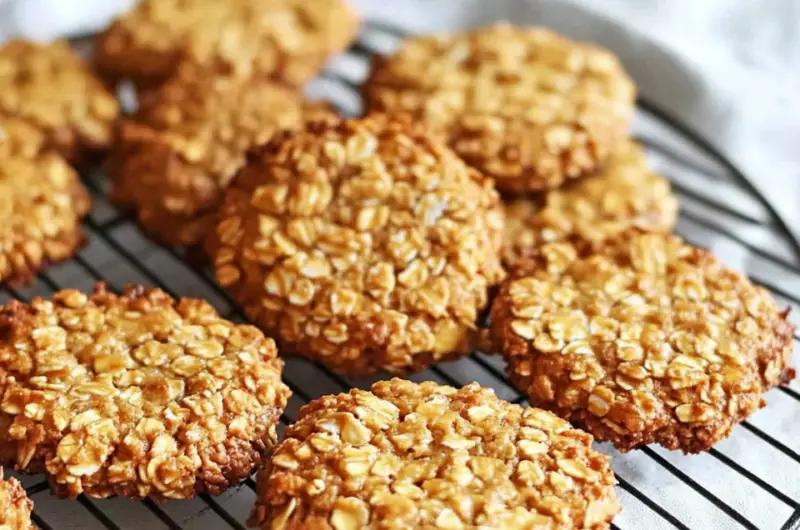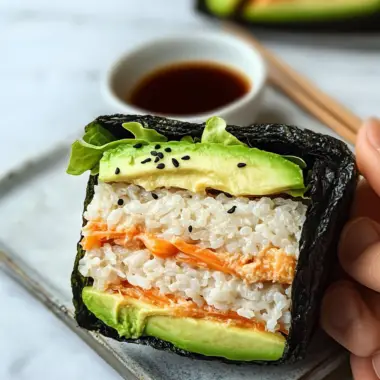The ANZAC Biscuit is more than just a sweet snack it’s a nostalgic icon rooted in history. Originally sent by loved ones to soldiers abroad during World War I, these biscuits were designed to last the long journey while still delivering comforting flavors. Made with simple, pantry-friendly ingredients like oats, coconut, and golden syrup, they boast a wonderful balance of chewy and crunchy textures. Perfect with a cup of tea or packed into lunchboxes, ANZAC Biscuits continue to be a beloved tradition in Australian and New Zealand homes. Their long shelf life makes them ideal for make-ahead baking, and they’re wonderfully versatile easy to tweak for a crispier texture or a softer bite. Whether you bake them in honor of ANZAC Day or as a cozy treat year-round, they’re a delicious tribute to heritage and simplicity.
Full Recipe:
Ingredients:
-
1 cup rolled oats
-
1 cup desiccated coconut
-
1 cup plain flour
-
3/4 cup brown sugar
-
125g unsalted butter
-
2 tablespoons golden syrup
-
1/2 teaspoon baking soda
-
2 tablespoons boiling water
Directions:
-
Preheat oven to 160°C (320°F). Line baking trays with parchment paper.
-
In a large bowl, mix together oats, coconut, flour, and brown sugar.
-
In a saucepan over low heat, melt butter and golden syrup together.
-
In a small bowl, combine baking soda and boiling water, then stir into the butter mixture (it will foam slightly).
-
Add the wet mixture to the dry ingredients and stir until combined.
-
Roll tablespoonfuls of the mixture into balls, place them on trays, and flatten slightly.
-
Bake for 12-15 minutes or until golden brown. Let cool on trays before transferring to wire racks.
Prep Time: 10 minutes | Cooking Time: 15 minutes | Total Time: 25 minutes
Kcal: 120 kcal | Servings: 20 biscuits
ANZAC Biscuits: A Classic Taste of Australian and New Zealand Heritage
ANZAC Biscuits are more than just a sweet treat they are a cultural icon in both Australia and New Zealand. Their origins, simplicity, and enduring popularity have solidified their place in kitchens around the world, especially in households where tradition and remembrance are cherished. Often associated with ANZAC Day on April 25th, these biscuits pay homage to the Australian and New Zealand Army Corps (ANZAC) soldiers of World War I.
This beloved biscuit, made from humble pantry staples like oats, coconut, and golden syrup, continues to be baked and enjoyed today, not just for its history, but for its delicious taste and versatility.
The Origin and Historical Significance
The ANZAC Biscuit has roots dating back to World War I. While exact records vary, it’s widely believed that these biscuits were made by women on the home front and sent in care packages to soldiers fighting abroad. Because the ingredients were affordable and long-lasting there were no eggs or dairy involved they were ideal for withstanding the long journey by sea.
The absence of eggs, which were scarce during wartime, was strategic. The result was a sturdy, chewy, and slightly crisp biscuit that could survive weeks of transit without spoiling. Golden syrup served as a key binding agent, replacing eggs while adding a rich caramel flavor.
Over time, ANZAC Biscuits have come to symbolize not only national pride and remembrance but also resilience and ingenuity in the face of hardship. They’re especially popular around ANZAC Day but are enjoyed year-round by many families.
What Makes ANZAC Biscuits Unique?
ANZAC Biscuits are known for their unique texture a delightful combination of crisp edges and a chewy center. The interplay of rolled oats and desiccated coconut gives the biscuit a hearty and rustic mouthfeel, while golden syrup imparts a depth of flavor and subtle sweetness. Unlike many modern cookie recipes, ANZAC Biscuits don’t rely on chocolate, frosting, or other embellishments. Their charm lies in their simplicity.
What truly makes them stand out is the flavor profile: buttery and caramel-like from the golden syrup and butter, with the nutty richness of oats and the tropical aroma of coconut. These flavors combine to produce a biscuit that is both comforting and satisfying.
Versatility and Customization
While the classic ANZAC Biscuit recipe remains largely unchanged, many home bakers enjoy adding their own spin. Depending on taste and texture preferences, the recipe can be slightly adjusted for different outcomes:
-
Crispy vs. Chewy: To make them crispier, extend the baking time by a few minutes. For a chewier center, reduce baking time slightly and avoid over-flattening the dough balls.
-
Additions: While not traditional, some people add chopped dried fruits like apricots or sultanas, or even a handful of dark chocolate chips for a modern twist.
-
Healthier Versions: Substituting butter with coconut oil and using whole wheat flour can create a healthier variation without losing the integrity of the biscuit.
-
Vegan-Friendly: Since the traditional recipe doesn’t use eggs, it’s already close to being vegan. Replacing the butter with a plant-based alternative makes it entirely vegan.
These subtle tweaks can make the ANZAC Biscuit suitable for a variety of dietary preferences and occasions, without straying too far from its roots.
Baking Tips for Perfect ANZAC Biscuits
While ANZAC Biscuits are relatively simple to make, here are some tips to ensure the best results:
-
Watch the syrup: When melting the butter and golden syrup together, take care not to overheat. A gentle melt is all that’s needed.
-
Don’t skip the baking soda reaction: Mixing boiling water with baking soda and adding it to the syrup mixture causes it to foam this chemical reaction is key to getting the right texture.
-
Shape and spacing: Roll dough into uniform balls and flatten slightly to ensure even cooking. Leave space between them as they will spread during baking.
-
Cooling matters: Let the biscuits cool on the baking tray before transferring them to a rack. They firm up as they cool and may fall apart if moved too early.
These tips ensure that each biscuit comes out golden, crisp at the edges, and deliciously chewy in the center.
Cultural Relevance and Modern Celebrations
ANZAC Biscuits hold a special place in national ceremonies and family traditions. On ANZAC Day, which commemorates the sacrifices of soldiers in war, these biscuits are often baked at home, sold at fundraising events, or served at memorial services.
In schools and community centers, baking ANZAC Biscuits is also a popular educational activity. It helps children learn about history, wartime hardships, and the importance of remembrance, all through the practical and engaging experience of baking.
Beyond ANZAC Day, these biscuits are found in cafes, lunchboxes, and kitchen counters across Australia and New Zealand. Their popularity has even extended to international markets, where they are embraced by expats and curious food lovers alike.
Storing and Gifting Ideas
One of the many benefits of ANZAC Biscuits is their excellent shelf life. When stored in an airtight container, they can last up to two weeks without losing their texture or flavor. This makes them perfect not just for personal enjoyment but also as a thoughtful gift.
Packaged in a decorative tin or wrapped in rustic brown paper with twine, ANZAC Biscuits make a wonderful homemade gift for birthdays, holidays, or thank-you gestures. Their historical charm and delicious flavor are sure to be appreciated by anyone who receives them.
Conclusion:
ANZAC Biscuits are a beautiful example of how food can serve as both sustenance and a symbol. They represent the innovation and compassion of a generation that found a way to support soldiers overseas through homemade care packages. Today, they continue to bring people together, providing a link to the past and a treat that’s as tasty as it is meaningful.
Whether you’re baking them as part of an ANZAC Day tradition, sharing them with loved ones, or simply enjoying a sweet moment with your tea, ANZAC Biscuits deliver both comfort and history in every bite. Their classic flavor, easy preparation, and emotional resonance make them a recipe worth passing down for generations to come.








